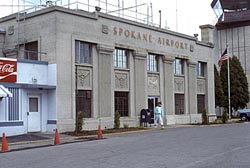
Felts Field, established in Spokane, Washington, in 1926, was the Inland Northwest's first airport and one of the oldest Federally designated airports in the nation. It served as the region's principal commercial and military airport through the 1940s and was the location of the region's first National Guard Air Unit. In the wake of World War I, former army pilots and surplus airplanes led to a national surge in aviation activities. Felts Field was designated a municipal air field (under the name Earl Hoisington Field) by the city and in February 1919, the Northwest Aircraft Company leased 1,000 acres at the field from the city. Before the end of the year, the firm was flying passengers to Lewiston, Tacoma and Seattle. Other air firms followed, such as the Spokane Aviation Company and the United States Aircraft Company, setting up operations at the field in the early 1920s. In 1924, the region's first National Guard formed and located here and in 1927, construction began on a new headquarters building that still stands. The real growth of the airport began with the arrival of airmail service in 1929. On August 15th,1929, Lt. Nick Mamer and Art Walker took off from Felts Field in their Spokane Sun-God and stayed in the air for 120 hours travelling from Spokane to New York and returning to Felts Field on August 20th. This 7,200-mile trip set several records, including the first transcontinental refueling, the first refueling above 8,000 feet and the world's record nonstop mileage.

The buildings and airfield of the Felts Field Historic District illustrate the formative years of commercial and military aviation from the late 1920s through 1941. The airfield, surrounded by expansive open space, remains almost unchanged since the runways were first paved around 1940. The historic buildings of the district--three aircraft hangars, a passenger terminal, the National Guard headquarters, a small storage building, clock tower and a free-standing metal and neon sign--are located along Rutter Avenue parallel to the landing strip. At one end of this row of buildings is the Northwest Airlines Company hangar, a large wood frame building from the mid-1930s with Art Deco details. The 1932 Terminal Building also reflects the streamlined motifs of the Art Deco period, and a bas-relief molding of Pegasus ornaments the central entry. The terminal reflects the growth in commercial aviation during this period and originally housed United Airlines offices (which began operating here in 1931), ticket and waiting areas, as well as the weather bureau. The dramatic moderne clock tower was constructed in 1939 as a memorial to pilot Lt. Mamer and nine others killed in a commercial airplane crash the previous year.

As the airport became busier with military and general aviation traffic in the years leading to World War II, it became apparent that Felts Field was not large enough to accommodate the increased activity. Another airport was constructed in 1940 and by 1949, military and commercial traffic had moved permanently to what was later named Spokane International Airport. Felts Field continued to serve as a general aviation facility.
Visit the National Park Service Travel American Aviation to learn more about Aviation related Historic Sites.
Last updated: September 3, 2017
